Introduction
Hey there, fellow rabbit lovers! Winter is just around the corner, and as responsible bunny owners, it’s essential for us to ensure the well-being and comfort of our adorable companions.
Winter can be a bit challenging for rabbits, who are sensitive creatures that require extra care to thrive in low temperatures. From managing humidity levels to preventing frostbite, we’ll cover it all to help you keep your bunnies happy and healthy throughout the winter season.
Have you ever wondered about the ideal humidity levels for rabbit hutches? We’ll explore the importance of managing humidity and provide practical tips on maintaining optimal levels.
But that’s not all! Emergency preparedness is crucial in case unexpected situations arise during winter.
And of course, we can’t forget about warmth and insulation. Rabbits need that extra coziness to beat the cold, so we’ll dive into effective methods for winterizing outdoor hutches, preventing frostbite, and selecting rabbit-friendly fabrics that will keep your furry friends snug as a bug.
So grab a cup of hot cocoa and get ready to become a winter-wizard bunny owner. Let’s ensure our rabbits have a wonderful winter season filled with love, warmth, and endless cuddles.
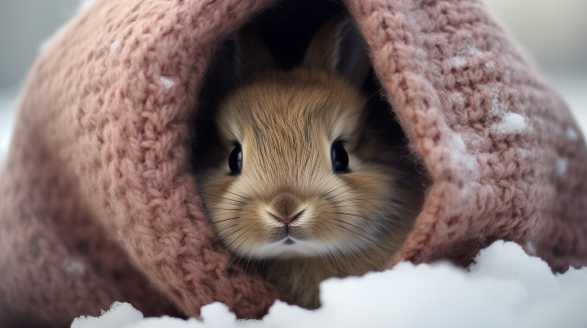
Key Takeaways
- Proper insulation is crucial for keeping rabbits warm and comfortable during winter.
- Choose insulation materials such as straw, hay, foam boards, or bubble wrap to line the hutch and create an extra layer of warmth.
- Ensure proper ventilation in the hutch to prevent moisture buildup while still allowing fresh air circulation.
- Minimize heat loss by sealing gaps and positioning the hutch against insulated walls.
- Provide a cozy hideout and warm bedding for your rabbit’s sleeping area.
- Monitor their water supply regularly to prevent freezing.
- Consider bringing your rabbit indoors during extremely cold weather.
Managing Humidity Levels in Rabbit Hutches during Winter
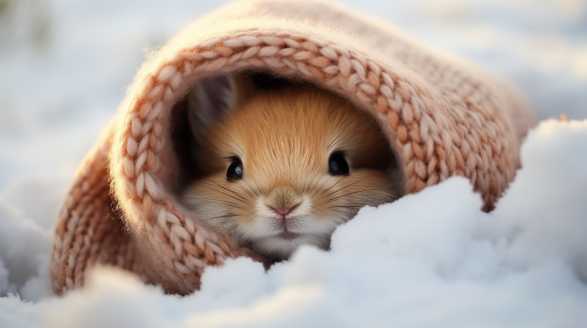
As a rabbit owner, I understand the importance of providing a comfortable and safe environment for these adorable creatures, especially during the winter months. One of the key factors to consider is managing humidity levels in rabbit hutches.
Why is Managing Humidity Important?
Humidity refers to the amount of moisture in the air. High humidity levels can lead to moisture buildup, which can result in a damp and uncomfortable living environment for rabbits.
On the other hand, low humidity levels can cause dryness and discomfort for rabbits, leading to itchy skin, cracked paws, and other related problems. Therefore, it is crucial to strike a balance and maintain optimal humidity levels in rabbit hutches during winter.
Understanding Optimal Humidity Levels
Before delving into the strategies for managing humidity in rabbit hutches, let’s understand the ideal humidity levels for rabbits. Generally, rabbits thrive in humidity levels ranging from 40% to 60%.
Tips for Managing Humidity Levels
Let’s now explore some effective methods to manage the humidity levels in rabbit hutches during winter:
1. Choose the Right Bedding Material
Choosing the right bedding material is crucial for maintaining optimal humidity levels. Avoid bedding materials that retain excessive moisture, such as fabrics and wood shavings.
These materials can help regulate moisture levels by absorbing excess moisture while still providing comfort to your rabbits.
2. Provide Proper Ventilation
Proper ventilation is essential to prevent humidity buildup. Make sure your rabbit hutch has enough ventilation openings or mesh areas to allow air circulation.
However, ensure that the ventilation is not excessive, as extreme cold drafts can be harmful to your rabbits. Striking a balance is key.
3. Use Insulation to Regulate Temperature and Humidity
Insulating the rabbit hutch can be beneficial in maintaining optimal humidity levels. Insulation helps regulate temperature, which indirectly affects humidity levels.
Consider insulating the walls, roof, and floor of the hutch using materials like polystyrene or waterproof blankets.
4. Regularly Clean and Dry the Hutch
Regular cleaning and drying of the rabbit hutch are essential to prevent moisture buildup. Remove any damp or soiled bedding promptly, as it can contribute to humidity issues.
5. Avoid Overcrowding
Overcrowding can exacerbate humidity problems in rabbit hutches. Ensure that your rabbits have ample space to move around and breathe freely.
Provide separate living spaces for multiple rabbits to prevent overcrowding and maintain better humidity control.
6. Monitor and Control Humidity Levels
Investing in a hygrometer is an excellent step towards managing humidity levels effectively. A hygrometer is a device that measures humidity levels in the hutch.
Some hygrometers also come with humidity control features, making it easier to regulate humidity automatically.
Managing humidity levels in rabbit hutches during winter is crucial for the overall well-being of your furry friends. By following the tips and techniques discussed in this article, you can ensure a comfortable and safe living environment for your rabbits throughout the winter season.
Your rabbits will thank you for creating a cozy and balanced habitat!
Winter Emergency Preparedness for Rabbit Owners: What to Know
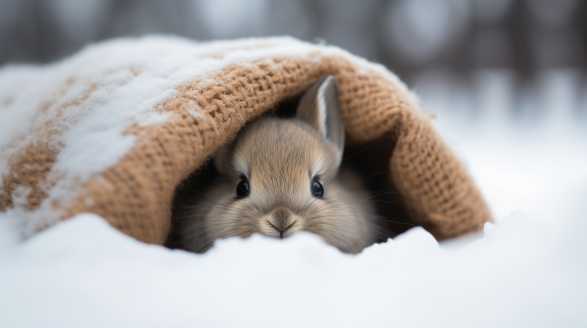
As a devoted rabbit owner myself, I understand the importance of ensuring the safety and well-being of our furry friends, especially during the winter season. It’s crucial to be prepared for unexpected emergencies that may arise during this time.
Let’s dive in!
Understanding the Vulnerabilities of Rabbits in Winter
Rabbits are particularly sensitive to extreme temperatures, making them vulnerable during the winter season. Exposure to low temperatures can lead to hypothermia, frostbite, and even death.
Preparing the Rabbit Hutch
The rabbit’s hutch acts as their shelter and sanctuary. Here are some key steps to ensure it is winter-ready:
- Insulation:
- Line the hutch’s walls and floor with insulated materials like thermal insulation panels.
- Cover the hutch with weatherproof and waterproof covers to prevent drafts and rain leakages.
- Elevate the Hutch:
- Raise the hutch off the ground using wooden blocks or bricks to prevent the floor from getting too cold.
- Ensure proper ventilation while maintaining insulation to prevent condensation.
- Bedding:
- Provide warm and cozy bedding such as straw or hay, which offers insulation and warmth.
- Regularly check and change bedding to keep it dry and fresh for your rabbits.
- Heat Source:
- Consider using a pet-safe heat pad or a heat lamp to maintain a comfortable temperature inside the hutch.
- Position the heat source carefully, ensuring that rabbits cannot directly come into contact with it to avoid burns.
Feeding and Hydration
Proper nutrition and hydration are essential for your rabbits to stay healthy and maintain body temperature effectively. Here are some tips to ensure their needs are met:
- Balanced Diet:
- Discuss with your veterinarian to ensure your rabbits are getting an appropriate diet suitable for winter.
- Provide a variety of fresh vegetables and high-quality hay to meet their nutritional requirements.
- Heated Water Bowl:
- Invest in a heated water bowl to prevent the water from freezing during extremely cold weather.
- Regularly check and refill the water bowl to ensure your rabbits have constant access to fresh water.
- Additional Food and Snacks:
- Increase the food portions during colder days, as rabbits require more energy to keep warm.
- Supplement their diet with occasional treats like carrots and apple slices, which can improve their mood and well-being.
Monitoring the Health of Your Rabbits
During winter, rabbits may be more susceptible to certain health issues. Keeping a close eye on their well-being is vital.
Signs of Hypothermia
Hypothermia can be life-threatening for your rabbits. Watch out for the following symptoms:
- Shivering
- Hunched posture or reluctance to move
- Cold ears and extremities
- Pale or blueish coloration of the skin
- Lethargy or decreased appetite
If you notice any of these signs, seek immediate veterinary assistance.
Frostbite Prevention
Frostbite commonly affects rabbit extremities like ears, nose, and toes. To prevent it:
- Ensure the hutch is well-insulated and free from drafts.
- Avoid taking your rabbits outdoors for extended periods during extremely cold weather.
If frostbite occurs, contact your veterinarian for guidance on how to manage and treat it appropriately.
Emergency Preparedness
Despite our best efforts, emergencies can still occur. Here are some essential tips to be prepared for unforeseen situations:
- Emergency Kit:
- Prepare an emergency kit containing essential items like a first aid kit, extra bedding, a heat source, and emergency contact information for your veterinarian.
- Emergency Plan:
- Develop a clear plan of action outlining steps to follow in case of emergencies such as power outages or extreme weather conditions.
- Identify a temporary warm location where your rabbits can be safely relocated if needed.
- Contact Information:
- Ensure you have phone numbers for your veterinarian, local animal hospitals, and emergency veterinary clinics readily available.
Winter emergency preparedness for rabbit owners is of utmost importance to ensure the well-being and safety of our beloved pets. By following the tips outlined in this article and staying vigilant, you can be better equipped to handle unexpected situations.
Stay prepared and keep them safe throughout the winter season.
Hot Water Bottles and Heat Pads: Bunny-approved Warming Solutions
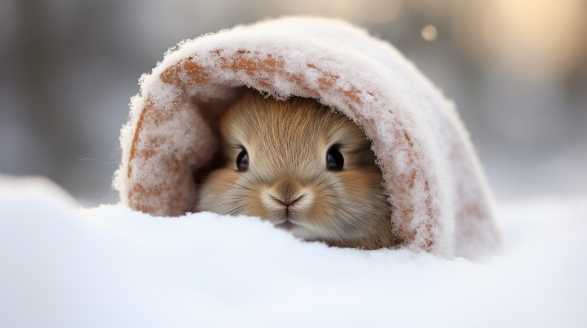
As a proud bunny owner, I always prioritize my furry friend’s comfort and well-being. And when those chilly winter nights start to creep in, providing sufficient warmth becomes even more essential.
Hot water bottles and heat pads are my go-to options, offering comfort and coziness to my bunny during colder seasons. I will discuss the benefits, usage tips, and safety precautions to ensure a comfortable and happy bunny!
Why Hot Water Bottles and Heat Pads?
Rabbits are sensitive animals that thrive in comfortable temperatures. Just like us, they seek warmth during colder days to maintain their optimal body temperature.
Providing them with the right warmth helps prevent these problems and keeps them happy and healthy.
Hot water bottles and heat pads are fantastic choices for keeping your bunny cozy. Not only are they easy to use and readily available, but they can also be adjusted to the perfect temperature according to your bunny’s preferences.
Hot Water Bottles: Warmth in a Snuggly Package
Hot water bottles have been trusted companions for decades, and they are just as effective for our furry friends. Here are some of the reasons why hot water bottles are bunny-approved warming solutions:
- ### Soothing Warmth
Hot water bottles offer soothing warmth that mimics the comforting feeling of a bunny cuddle. Their plush covers provide an extra layer of coziness, making them a favorite among bunnies.
- ### Portable and Versatile
You can take hot water bottles anywhere your bunny goes! Whether it’s inside their favorite hiding spot, in their carrier during travels, or tucked into their bed, hot water bottles are versatile and easy to move around.
- ### Long-lasting Warmth
Hot water bottles can retain heat for several hours, providing your bunny with continuous warmth. This is especially useful during icy nights or when you’re away for longer periods.
- ### Adaptable for All Seasons
Hot water bottles are not exclusively for cold weather. During scorching summer days, simply fill them with cold water and pop them in the freezer to create a refreshing cooler for your bunny.
Usage Tips for Hot Water Bottles
Now that you understand the benefits of hot water bottles let’s dive into some essential usage tips to ensure your bunny’s safety and maximum comfort:
- ### Material Matters
Choose a hot water bottle made from high-quality materials that are safe for your bunny. Opt for bottles with a soft and removable cover that is machine washable for easy cleaning.
- ### Temperature Test
Always test the temperature of the hot water bottle before placing it near your bunny. Ensure it is warm, not scalding hot.
If it feels comfortably warm, it’s safe for your bunny.
- ### Layer it Up
Place a soft layer of bedding or a blanket between the hot water bottle and your bunny’s skin to avoid direct contact and potential burns. This will also provide additional comfort and insulation.
- ### Monitor and Adjust
Regularly check the hot water bottle’s temperature and adjust as needed. Your bunny’s comfort should always be your top priority, so ensure the warmth level is just right.
Heat Pads: Cozy Warmth at the Click of a Button
Heat pads, also known as microwaveable heating pads or electric heat pads, are another fantastic warming solution for rabbits. They offer convenience and can be easily customized to provide your bunny with the perfect warmth.
- ### Quick and Effortless
Heat pads are incredibly easy to use. Simply heat them in the microwave or plug them into an electrical outlet, and they are ready to provide instant warmth to your bunny.
- ### Temperature Control
Depending on the type of heat pad, you can usually adjust the temperature to suit your bunny’s needs. This allows you to find the perfect balance of warmth and comfort.
- ### Durable and Long-lasting
Heat pads are designed to withstand regular use and are built to last. This makes them a reliable investment that will keep your bunny warm for many winters to come.
- ### Safe and Convenient
Modern heat pads come with built-in safety features, such as auto-shutoff timers, to prevent overheating and ensure your bunny’s safety. They are also lightweight and portable, making them easy to move around as needed.
Usage Tips for Heat Pads
Just like any other heating solution, heat pads require careful handling and monitoring to ensure your bunny’s utmost comfort and safety. Here are some tips to help you make the most out of your heat pads:
- ### Read the Instructions
Always follow the manufacturer’s instructions for your specific heat pad model. This will ensure proper usage and prevent any accidents.
- ### Avoid Direct Contact
Place a soft layer of bedding or a towel between the heat pad and your bunny to avoid direct contact. This will prevent burns and provide extra comfort.
- ### Keep an Eye on Cables
If you’re using an electric heat pad, make sure to keep the cables out of your bunny’s reach to avoid chewing hazards.
- ### Regularly Inspect for Wear and Tear
Before each use, inspect the heat pad for any signs of wear and tear. If you notice any damage or frayed wires, it’s time to replace it for your bunny’s safety.
Hot water bottles and heat pads are excellent options to keep your beloved bunny warm and cozy during colder seasons. Their portable nature, adaptability, and customizable temperature control make them reliable heating solutions.
With a warm bunny snuggled up in comfort, you can enjoy the winter season worry-free!
Winterizing Outdoor Rabbit Hutches: Essential Tips and Tricks
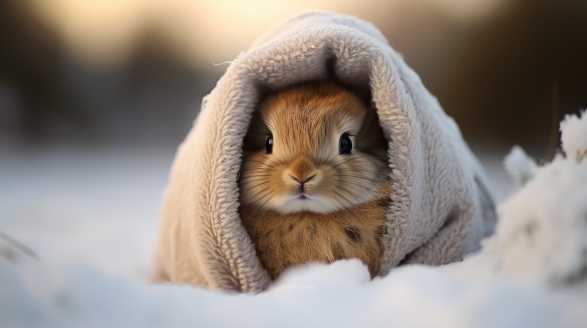
As a lifelong rabbit enthusiast, I understand the importance of providing a safe and comfortable habitat for our furry friends, especially during the colder winter months. Winterizing outdoor rabbit hutches is crucial to ensure the well-being and health of our beloved pets.
So, grab a warm cup of tea and let’s dive into the wonderful world of winterizing rabbit hutches!
Why Winterizing is Important
Rabbits are delicate creatures that cannot tolerate extreme temperatures. Freezing cold temperatures can be particularly harsh on them, leading to various health issues, including hypothermia.
Preparing the Hutch
Before the winter season arrives, it’s vital to ensure that the rabbit hutch is in good condition. Take the following steps to prepare the hutch for the colder months:
- Inspect the hutch: Check the hutch thoroughly for any signs of damage, such as cracks, holes, or loose parts. Repair or replace damaged sections to prevent drafts and unwanted visitors.
- Clean the hutch: Give the entire hutch a thorough cleaning. Remove any droppings, hay, or debris, and wash the surfaces with a mild rabbit-safe detergent. A clean hutch will help maintain a healthy living environment for your rabbits.
Providing Insulation
Insulating the hutch is crucial to retain warmth and prevent drafts. Here are some effective ways to insulate the hutch:
- Add extra bedding: Increase the amount of bedding in the hutch during winter. Straw or hay is excellent for providing insulation. Create a thick layer to keep your rabbits warm and cozy.
- Use insulating materials: Attach sheets of insulating materials, such as foam boards or polystyrene, to the walls of the hutch using non-toxic adhesive. This will provide an additional barrier against the cold weather.
- Cover the hutch with blankets: Drape thick blankets over the hutch, ensuring they do not completely block airflow. This will create an extra layer of insulation while still allowing fresh air to circulate.
Draft Control and Ventilation
While insulation is essential, it’s equally vital to maintain proper ventilation and control drafts within the hutch. Here’s how you can strike the right balance:
- Seal any gaps: Inspect the hutch for any gaps or openings that may allow cold air to seep in. Seal these gaps with weather-resistant sealant or cover them with materials like plywood.
- Provide ventilation: Install vents near the top of the hutch to allow fresh air circulation. This prevents the buildup of harmful ammonia gases from urine and feces. Ensure the vents have covers to regulate airflow during heavy snow or rain.
Providing Extra Heat
Sometimes, insulation alone may not be enough to keep your rabbits warm during extremely cold temperatures, especially for vulnerable or elderly rabbits. Here are some ways to provide extra heat:
- Heat pads or blankets: Invest in rabbit-safe heating pads or blankets designed specifically for small animals. Place them underneath a layer of bedding to provide a gentle and constant source of warmth.
- Heat lamps: Consider using heat lamps to provide additional heat. Ensure they are securely attached and positioned in a way that doesn’t pose a fire hazard or cause direct exposure to your rabbits.
Food, Water, and Exercise
Proper nutrition, hydration, and exercise are essential year-round, including in the winter. Here are some tips to ensure your rabbits’ well-being in these aspects:
- Water management: Use heated water bottles or bowls to prevent water from freezing. Check them regularly to ensure a constant supply of fresh, unfrozen water.
- Diet adjustments: Increase the amount of hay provided during colder months. Hay provides essential fiber and helps maintain body heat during digestion. Also, consider adding warm foods like oats or fresh herbs to their diet to provide extra warmth.
- Exercise and playtime: Even in winter, it’s important to allow your rabbits time outside their hutch for exercise and mental stimulation. Create a secure and supervised play area indoors, ensuring it’s free from hazards and drafts.
Additional Tips and Tricks
Here are a few extra tips and tricks to maximize your rabbits’ comfort during winter:
- Position the hutch: Place the hutch away from icy winds and direct exposure to rain or snowfall. Consider placing it against a wall or under a covered area.
- Use natural sunlight: Ensure the hutch receives as much natural sunlight as possible during the day. Sunlight helps generate warmth and provides a natural source of vitamin D for your rabbits.
- Monitor temperature: Regularly check the temperature inside the hutch to ensure it remains within a safe range. Invest in a reliable thermometer to easily monitor the environment.
- Observe rabbit behavior: Pay close attention to your rabbits’ behavior. If you notice excessive shivering, reduced activity, or other signs of distress, take immediate action to provide extra warmth or consult a veterinarian.
Winterizing outdoor rabbit hutches is essential to guarantee the comfort and well-being of our furry companions during the colder months. By following these essential tips and tricks, you can create a cozy and safe environment for your rabbits.
Stay warm, and happy winterizing!
Preventing Frostbite in Rabbits: Essential Winter Care
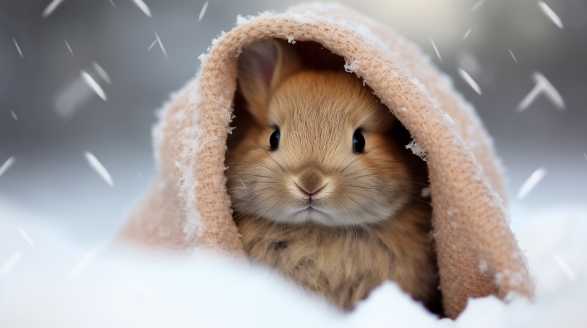
As a dedicated rabbit owner, ensuring the well-being of your furry friend should be your top priority, especially during the cold winter months. One of the most significant dangers rabbits face in winter is frostbite.
It can lead to tissue damage and even amputation if left untreated. To protect your rabbit from the severe consequences of frostbite, follow these essential winter care tips:
Provide a Well-Insulated Shelter
A properly insulated shelter is crucial for preventing frostbite in rabbits. Make sure your rabbit’s enclosure or hutch is well-insulated to keep the cold air out and provide a cozy environment.
- Use plywood or solid material for the walls of the enclosure to block out drafts.
- Line the floor with thick blankets, straw, or hay to provide extra insulation from the cold ground.
- Cover the hutch with a waterproof tarp or specialized hutch covers to protect it from wind and moisture.
- Place the hutch in a sheltered area, away from direct wind or cold drafts.
Bedding Choices
Choosing appropriate bedding for your rabbit’s hutch is crucial during winter. Opt for bedding materials that offer excellent insulation and moisture control to keep your rabbit warm and dry.
- Straw: Straw is a popular choice for rabbit bedding as it provides excellent insulation and helps retain warmth. Ensure the straw is dry and regularly check for moisture buildup.
- Hay: Besides being a dietary staple for rabbits, hay can also be used as bedding material. It has insulating properties and provides a comfortable surface for your rabbit to rest on.
- Fleece: Fleece bedding is a great alternative that provides warmth and comfort. It is soft on your rabbit’s feet and can easily be cleaned.
Increase Dietary Fat Content
During winter, it’s crucial to adjust your rabbit’s diet to help them maintain the proper fat reserves, which aid in protecting them against the cold. Adding a bit of extra fat to their diet can help provide the necessary energy to keep warm.
Check Water Sources Regularly
It’s essential to ensure your rabbit’s water supply remains unfrozen at all times. Rabbits need continuous access to fresh water, even during winter.
Check the water supply frequently to ensure it hasn’t frozen or become too cold for your rabbit to drink comfortably.
Provide Adequate Hay Supply
Hay is a vital component of a rabbit’s diet throughout the year, but it becomes even more critical during winter. Rabbits need a constant supply of hay to help keep warm and promote healthy digestion.
Always make sure there is an abundant supply of clean and fresh hay available for your rabbit.
Limit Outdoor Time
As temperatures drop, it is crucial to limit your rabbit’s time spent outdoors. Only allow your rabbit to venture out for short periods when the weather is milder.
Provide them with warm bedding and plenty of hay to keep them warm and comfortable.
Reduce Bathing During Winter
Rabbits are meticulous groomers, and they typically keep themselves clean without requiring frequent baths. However, during winter, it’s advisable to reduce or avoid bathing your rabbit altogether.
If your rabbit gets soiled, spot cleaning is preferred over full baths. If necessary, use a rabbit-safe dry shampoo or consult a professional groomer for assistance.
Monitor for Signs of Frostbite
Regularly inspect your rabbit’s ears, feet, and other exposed areas for any signs of frostbite. Be vigilant for the following symptoms:
- Pale, discolored, or blue skin
- Swelling or blisters
- Pain or discomfort when touched
- Crusty or dry skin
- Unwillingness to move or use affected limbs
If you notice any signs of frostbite, promptly seek veterinary care. Remember, early detection is crucial for successful treatment and preventing further complications.
Provide Extra Heat Sources
In extremely cold climates or for particularly vulnerable rabbits, supplementary heat sources can be beneficial. Here are some options to consider:
- Snuggle Safe heat pads: These pads can be warmed in the microwave and provide gentle heat for several hours.
- Heat lamps or ceramic heat emitters: These can offer a source of warmth in the rabbit’s shelter, but ensure they are used safely and do not pose a fire hazard.
- Insulated thermal blankets: Wrap your rabbit’s hutch with insulated thermal blankets to provide an extra layer of warmth. Keep in mind ventilation requirements and avoid overheating the enclosure.
Regularly Check Your Rabbit’s Extremities
Pay close attention to your rabbit’s feet and ears as these are the most susceptible areas to frostbite. Inspect them daily for any signs of cold-related damage and provide necessary interventions if required.
Seek Veterinary Advice
If you have any concerns about your rabbit’s well-being or need specific winter care advice, it is always best to consult your veterinarian. They can offer personalized recommendations based on your rabbit’s individual needs and help ensure they remain safe and comfortable during the winter months.
By following these essential winter care tips, you can effectively prevent frostbite in your rabbit and provide them with the necessary protection and comfort they need during the colder months. Remember, your rabbit depends on you to provide a safe and warm environment, so be proactive in keeping them happy and healthy all year round.
Safe and Effective Rabbit Bedding Options in Cold Weather
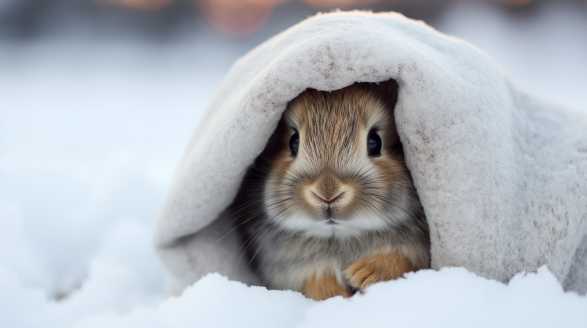
When the temperature drops, it’s essential to ensure that our fluffy companions, like rabbits, have a safe and cozy environment to stay warm and comfortable. One crucial aspect of their living conditions is the choice of bedding.
From natural materials to synthetic options, I’ve got you covered!
Why is Rabbit Bedding Important in Cold Weather?
Rabbits are susceptible to low temperatures, just like humans. They need extra warmth and insulation to prevent hypothermia and other cold-related issues.
Additionally, bedding helps absorb moisture and odor, ensuring a clean and hygienic living space.
Natural Bedding Options
Hay
Hay is a popular and safe bedding option for rabbits. Not only does it provide warmth but also provides something for your furry friend to nibble on!
Make sure to provide a thick layer of hay to keep your rabbit cozy during the chilly winter nights.
Straw
Straw is another natural bedding option that provides a soft and comfortable surface for your rabbit. However, it is essential to note that not all straw is suitable for bedding.
Before using straw as bedding, ensure it is clean, dry, and free from mold or insects.
Pine Shavings
Pine shavings are a popular choice for bedding due to their affordability and aroma. However, it is crucial to use kiln-dried pine shavings specifically made for small animals like rabbits.
Replace the shavings regularly to maintain cleanliness and hygiene.
Aspen Shavings
Aspen shavings are another viable option for rabbit bedding. Similar to pine shavings, aspen shavings are dust-free and low in volatile oils.
Make sure to choose aspen shavings without any additives or scents that may irritate your pet’s respiratory system.
Paper-Based Bedding
Paper-based bedding, made from recycled paper or cardboard, is an eco-friendly and safe option for rabbits. These bedding materials are highly absorbent and help control odor effectively.
Choose products specifically designed for small animals and free from chemicals that can harm your pet.
Synthetic Bedding Options
Fleece
Fleece bedding is a popular choice among rabbit owners due to its softness and versatility. It provides excellent insulation and is easy to clean.
Combine the fleece with an absorbent layer, such as puppy pads or disposable bed mats, to control moisture effectively. Replace or wash the fleece regularly to maintain a hygienic environment.
Vet Bedding
Vet bedding, also known as non-slip bedding or vet fleece, is a synthetic option specifically designed for pets. It is made from a combination of polyester and acrylic fibers, providing warmth, comfort, and a non-slip surface for your rabbit.
Tips for Using Bedding in Cold Weather
- Layering: No matter which bedding option you choose, layering is key. Provide a thick layer of at least 2-3 inches to ensure proper insulation and warmth for your rabbit.
- Regular Cleaning: Keep your rabbit’s living space clean by removing soiled bedding and replacing it with fresh bedding. Regular cleaning prevents the accumulation of moisture and odor.
- Spot Check: Regularly inspect the bedding for signs of mold, mildew, or pests. Remove any contaminated bedding immediately and disinfect the area if necessary.
- Monitor Humidity: Cold weather often brings dry air, which can cause respiratory issues in rabbits. Use a hygrometer to monitor the humidity levels in your rabbit’s enclosure and consider using a humidifier if needed.
- Comfortable Temperature: While bedding provides warmth, it’s essential to maintain a comfortable indoor temperature for your rabbit. Keep the ambient temperature between 50-70°F (10-21°C) to ensure your furry friend’s well-being.
Choosing the right bedding is crucial to ensure your rabbit stays warm and comfortable during cold weather. Whether you opt for natural materials like hay or straw, or synthetic options like fleece or vet bedding, prioritize safety, comfort, and cleanliness.
The Best Rabbit-Friendly Fabrics for Winter
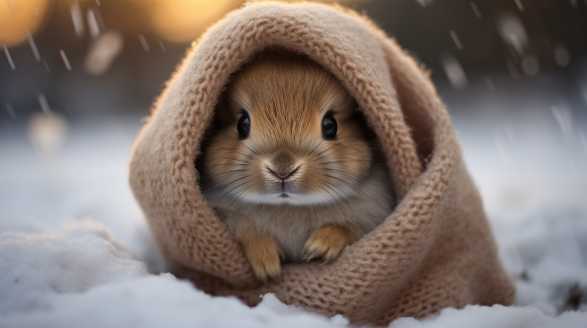
As a rabbit owner, providing a cozy and warm environment for your furry friend during the winter season is essential. Choosing the right fabrics for their bedding, accessories, and even your own clothes can make a difference in ensuring their comfort.
So, get ready to learn about some fantastic options that will keep your rabbits snug and happy!
Understanding Your Rabbit’s Needs
Before diving into the different fabrics, it’s important to understand what your rabbit needs to stay comfortable during winter. Rabbits are sensitive animals that require warmth and protection from cold temperatures.
It’s crucial to strike the right balance to prevent hypothermia or heatstroke.
Your rabbit’s living environment should have proper insulation, so start by ensuring their hutch or cage is well-insulated and draft-free. Additionally, allowing your rabbit to roam indoors during colder months is a great way to keep them warm and provide a safe space away from chilly drafts.
The Warmth and Comfort of Wool
Wool is well known for its excellent insulation properties, making it a fantastic choice for keeping rabbits warm in winter. Here are some rabbit-related items you can consider using wool fabrics for:
- Blankets: Whether it’s an additional layer for their hutch or a blanket for cuddling in your lap, wool blankets will keep your rabbits cozy and snug.
- Toys: Hand-knitted or felted wool toys are not only safe for rabbits but also provide insulation and entertainment.
- Bedding: Natural wool bedding acts as an excellent insulator and provides comfort for your rabbits. However, ensure it is clean and not too thick to avoid any overheating issues.
- Sweaters and Jackets: For outdoor playtime or a trip to the vet, wool sweaters or jackets designed specifically for rabbits can keep them warm and stylish.
The Softness of Fleece
Fleece is a versatile fabric that can be used for various purposes related to your rabbit’s needs during winter. Its soft texture and warmth make it a popular choice among rabbit owners.
- Cage Liners: Fleece makes for an ideal material to line your rabbit’s cage or hutch. It provides comfort, absorbs moisture, and is easy to clean. Make sure to change it regularly to maintain hygiene.
- Tunnels and Hideaways: Sewing or wrapping fleece around cardboard to create cozy tunnels and hideaways will not only keep your rabbits warm but also stimulate their natural instinct to burrow.
- Floor Mats: Cut fleece into small mats and place them in strategic spots inside your home where your rabbits love to relax. Fleece mats offer a soft, warm surface for your pets to rest on.
- Snuggle Sacks: Sewing fleece sacks or buying ready-made ones can serve as a warm and comfortable spot for your rabbits to retreat and feel secure.
The Versatility of Cotton
Cotton is a breathable fabric that can be an excellent choice for both winter and summer months. While it may not provide the same level of insulation as wool or fleece, it still offers a soft and cozy feel.
- Sleeping Bags: Cotton sleeping bags provide a comfortable and breathable environment for your rabbits to sleep in, ensuring a peaceful night’s rest.
- Lining for Carriers: When traveling with your rabbits in a carrier during colder months, lining it with cotton fabric will keep them comfortable without trapping excessive heat.
- Burrow Boxes: Create a burrow box for your rabbits using breathable cotton fabric. Adding hay or shredded paper inside will allow them to tunnel and stay warm during playtime.
- Bandanas and Scarves: For a fashionable twist, you can dress your rabbits up in cotton bandanas or scarves. Not only will they look adorable, but these accessories will also help keep them warm.
Caring for your rabbits during winter involves providing them with the right fabrics to ensure their comfort and well-being. By considering wool, fleece, and cotton materials for their bedding, toys, and clothing, you can create a warm and cozy environment for your furry friends.
Insulating Your Rabbit Hutch: Tips for Keeping Your Bunny Warm
As a proud rabbit owner, I know how important it is to ensure the comfort and well-being of our fluffy friends, especially during the chilly months. The colder temperatures can pose a risk to our bunnies, but fear not!
I will share with you my top tips for insulating your rabbit hutch.
Why is insulation important for rabbit hutches?
Before we dive into the tips, let’s understand why insulation is crucial for your rabbit’s hutch. Rabbits are sensitive to extreme temperatures, and they cannot regulate their body temperature as effectively as other animals.
Insulating your rabbit hutch will help maintain a comfortable and safe environment for your bunny.
Choosing the right materials for insulation
When it comes to insulating your rabbit hutch, choosing the right materials is key. Here are some excellent options:
- Straw or hay: These natural materials offer fantastic insulation properties and are also readily available. Line the floor of the hutch with a thick layer of straw or hay to help keep your rabbit warm.
- Insulating foam boards: These boards are lightweight and easy to work with. They provide excellent insulation and can be cut to fit any size of your hutch. Attach the foam boards to the inside walls of the hutch for optimal insulation.
- Bubble wrap: This might sound unconventional, but bubble wrap has insulating qualities due to the trapped air bubbles. Attach bubble wrap to the walls of the hutch to create an additional layer of warmth.
- Fleece blankets: Soft and cozy, fleece blankets can be used to line your rabbit’s sleeping area. These blankets provide extra warmth and comfort during colder nights.
Ensuring proper ventilation
While insulation is crucial, it’s equally important to ensure proper ventilation in your rabbit hutch. Good airflow will prevent the accumulation of dampness and condensation, which can be harmful to your bunny’s health.
- Wire mesh flooring: If your hutch has a wire mesh floor, make sure it is elevated to allow proper air circulation from underneath. This prevents the build-up of moisture in the hutch.
- Air vents: Create small vents in the hutch to promote air circulation. Place them on opposite sides of the hutch to allow for cross-ventilation.
- Avoid drafts: While ventilation is essential, be mindful of drafts. Position the hutch away from direct wind or cold air sources, such as windows or doors.
Minimizing heat loss
To ensure your rabbit stays warm inside the hutch, minimizing heat loss is crucial. Follow these tips to keep the cozy warmth where it belongs:
- Double-walled hutch: If possible, opt for a double-walled hutch design. This provides an extra layer of insulation and helps retain heat.
- Sealing gaps: Check for any gaps or cracks in the hutch that could let cold air in. Use weather-stripping or silicone caulk to seal these openings.
- Hutch location: Place the hutch against an insulated wall, such as a shed or your house. This can help shield it from cold winds, reducing heat loss.
Additional tips for a warm bunny hutch
- Add a cozy hideout: Provide your bunny with a cozy hideout inside the hutch. It can be a small wooden box or a specially designed bunny house. This creates a sanctuary for your rabbit to retreat to when it gets too chilly.
- Warm bedding: Along with insulation, ensure your bunny has warm bedding. Layer the sleeping area with soft blankets or bedding designed specifically for small animals. This adds an extra layer of warmth and comfort.
- Monitor water supply: Check your rabbit’s water bottle frequently during cold weather. Cold temperatures can freeze the water, so it’s important to keep an eye on it and provide fresh, unfrozen water regularly.
- Bring them indoors: In extremely cold conditions, consider bringing your bunny indoors. Set up a playpen or secure area where they can safely hop around and enjoy some warmth from your home.
Insulating your rabbit hutch is vital for keeping your bunny warm and comfortable throughout the chilly months. Remember to choose the right materials, ensure proper ventilation, and minimize heat loss.
Stay warm, bunnies!
Conclusion
In conclusion, winter can be a challenging time for our beloved rabbits, but with the right knowledge and preparation, we can provide them with a comfortable and cozy living environment. Managing humidity levels in rabbit hutches is crucial for their respiratory health, so choose the right bedding materials and ensure proper ventilation.
Insulating your rabbit hutch, providing warmth, and selecting rabbit-friendly fabrics will help keep your furry friends snug as a bug in the colder months.
By following these tips, such as choosing the right bedding material, providing proper ventilation, and using insulation, we can ensure our rabbits stay warm and comfortable during winter. Regular cleaning and drying of the hutch, avoiding overcrowding, and monitoring humidity levels are important for maintaining a healthy living environment.
And of course, providing extra warmth and insulation through bedding, heat sources, and selecting the right fabrics will help keep our bunnies cozy and happy.
Remember, our rabbits rely on us to provide them with the comfort and care they need to thrive during winter. By implementing these strategies and staying vigilant, we can ensure our furry friends have a wonderful winter season filled with warmth, love, and endless cuddles.
Stay warm, my fellow bunny enthusiasts!
Frequently Asked Questions
How do I keep rabbits warm in the winter?
To keep rabbits warm in the winter, you can:
- Provide them with a sheltered and insulated hutch.
- Add extra bedding such as straw or hay for insulation.
- Use heat lamps or heated pads cautiously to provide additional warmth.
- Keep their water from freezing by using a heated water bottle or changing it frequently.
- Ensure the hutch is protected from drafts.
Can rabbits handle cold temperatures?
Rabbits are more tolerant of cold temperatures than heat, but they still need protection. With the right precautions, such as providing shelter and insulation, rabbits can handle cold temperatures.
What temperature is too cold for rabbits?
Rabbits can handle temperatures below freezing, but prolonged exposure to temperatures below 20°F (-6°C) can be dangerous for them. It’s essential to provide a well-insulated hutch and take extra precautions during extreme cold weather.
How can I insulate a rabbit hutch?
To insulate a rabbit hutch:
- Ensure the hutch is well-constructed and free from drafts.
- Use insulating materials like straw or hay as bedding.
- Add an extra layer of insulation by covering the hutch with a waterproof tarp or blanket.
- Consider using a hutch cover specifically designed for insulation purposes.
Do rabbits need extra food in winter?
Rabbits have higher energy needs in winter to keep warm, so they might require slightly more food. However, overfeeding can lead to obesity, so it’s important not to overdo it.
What are the signs of a cold rabbit?
Signs of a cold rabbit can include:
- Shivering
- Huddling in a corner or staying in one spot for extended periods
- Cold ears and feet
- Lethargy or decreased activity
- Loss of appetite
If you notice these signs, take immediate steps to warm up your rabbit and consult a veterinarian if necessary.
Can rabbits stay outside in winter?
Rabbits can stay outside in winter, provided they have a suitable hutch that is well-insulated and protected from drafts. However, it’s important to monitor their well-being regularly and take necessary precautions, especially during extreme cold weather.
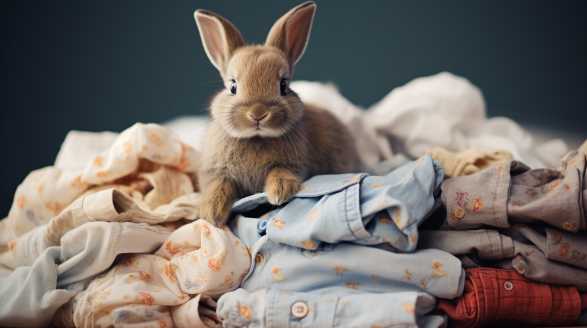
Why Do Rabbits Bite Your Clothes
Introduction Hey there, rabbit owners! We know how delightful it is to have these fluffy creatures hopping around our homes. Can you relate? Don’t worry, we’ve got your back! we’re diving into the fascinating world of rabbit behavior and tackling the topic of fabric chewing head-on. We’ll explore the reasons behind why rabbits have a […]
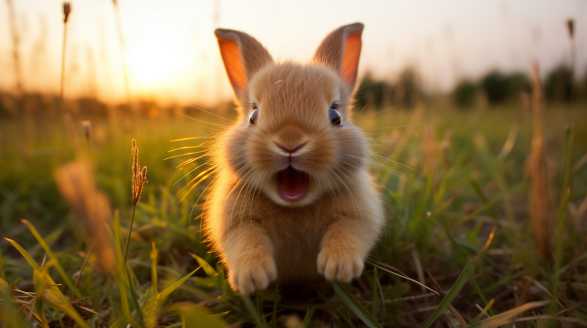
Do Rabbits Fart
Introduction Do rabbits fart? Let’s find out if Rabbits let them rip! Picture this: fluffy bunnies hopping through meadows, nibbling on carrots, their adorable faces innocent and unsuspecting. Little did we know they possessed the mysterious ability to unleash a gaseous fragrance that would captivate our senses and leave us in awe. Curiosity sparked, I […]
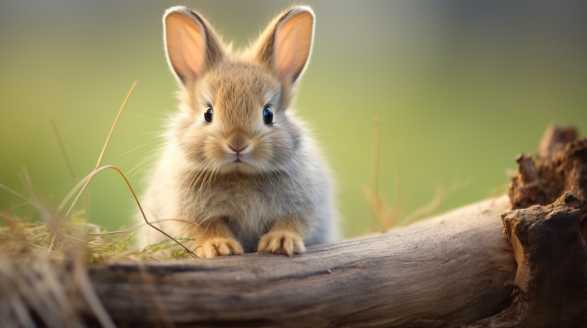
Do Rabbits Purr
Introduction Do rabbits purr? Let’s find out. Imagine this: you’re sitting in your cozy living room, cuddling with your beloved pet bunny. As you stroke its soft fur, you hear a low, rhythmic hum. Your eyes widen with curiosity as you wonder, “What does this purring mean? Is my bunny happy? Amazed by my petting […]
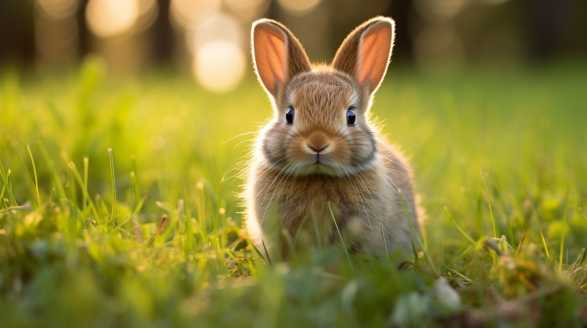
How To Stop Rabbits From Destroying Your Lawn
Introduction Hey there, fellow gardeners and lawn enthusiasts! We all love the sight of a perfectly manicured lawn, don’t we? That’s why I’m here today to share some fantastic solutions to help you reclaim your lawn from these furry invaders. we’ll explore a variety of chemical-free remedies and DIY methods to keep rabbits away from […]

How Much Do Rabbits Cost
Introduction How much do rabbits cost? Let’s find out. From the adorable bunnies to the mischievous adults, we’re going to uncover the real cost of raising these furry bundles of joy. And, it’s going to be a whirlwind ride! Picture this: fluffy bunnies bouncing around your home, their adorable little noses twitching with curiosity. As […]
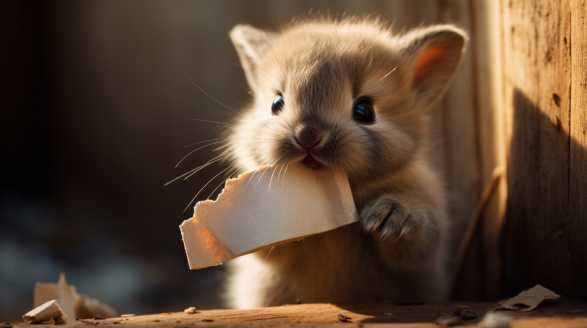
Can Rabbits Chew On Cardboard
Introduction Are you a proud rabbit owner who’s always wondered why your furry friend enjoys chewing on cardboard? Well, you’re not alone! That’s why we’ve dedicated this article to exploring the ins and outs of cardboard chewing in rabbits. We’ll dive into topics like whether it’s a sign of boredom, alternatives to cardboard, and how […]
